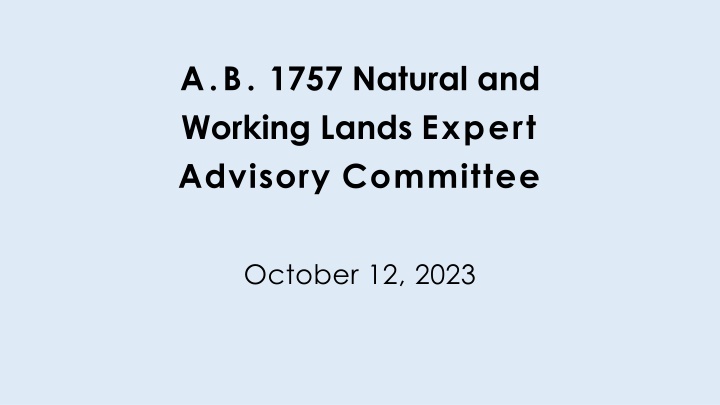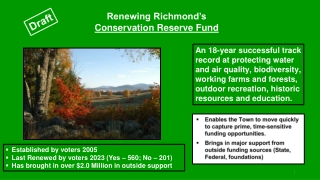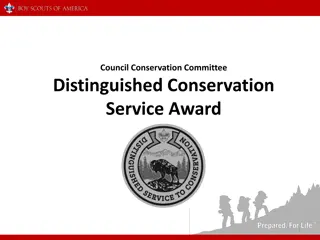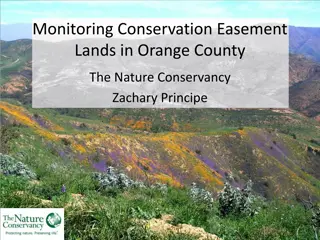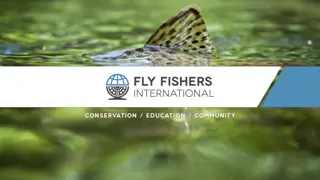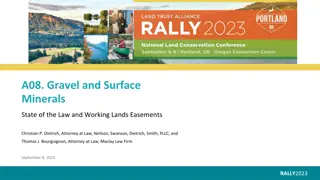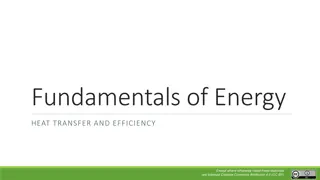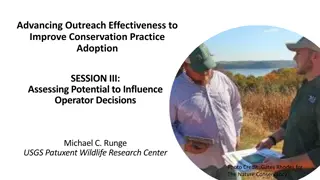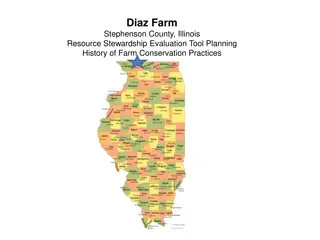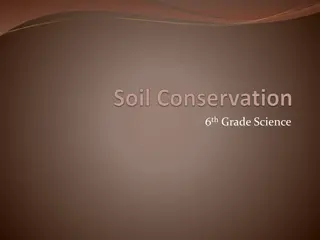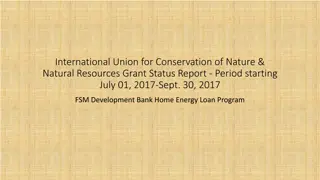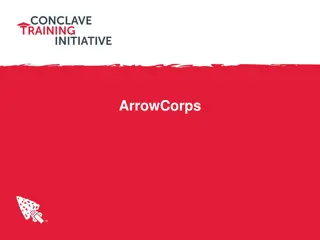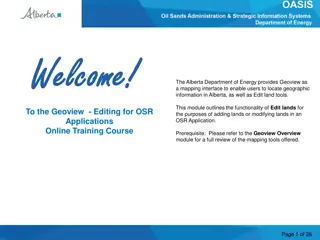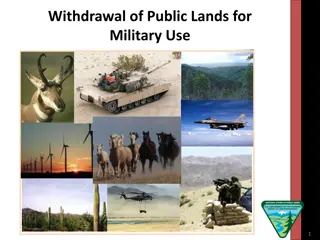Recommendations for Natural and Working Lands Conservation
The advisory committee discussed draft recommendations for conserving desert, agricultural lands, and grasslands. The proposals include minimizing disturbances, increasing conservation efforts, promoting organic agriculture, and enhancing soil cover to support ecosystem health.
Uploaded on Sep 06, 2024 | 2 Views
Download Presentation

Please find below an Image/Link to download the presentation.
The content on the website is provided AS IS for your information and personal use only. It may not be sold, licensed, or shared on other websites without obtaining consent from the author.If you encounter any issues during the download, it is possible that the publisher has removed the file from their server.
You are allowed to download the files provided on this website for personal or commercial use, subject to the condition that they are used lawfully. All files are the property of their respective owners.
The content on the website is provided AS IS for your information and personal use only. It may not be sold, licensed, or shared on other websites without obtaining consent from the author.
E N D
Presentation Transcript
A.B. 1757 Natural and Working Lands Expert Advisory Committee October 12, 2023
Todays Agenda 1. Welcome, Today s Agenda, Announcements, Roll Call 2. Informal Working Groups Reports & Discussion of Draft Recommendations from Committee 3. Next Steps, Future Meetings, and Closing
Item 1: Member Roll Call 1. Christy Brigham, National Park Service 2. John Callaway,University of San Francisco 3. Chelsea Carey, Point Blue 4. Nathanael Gonzales-Siemens, Rodale Institute 5. Matt Holmes, California Environmental Justice Coalition 6. William Horwath, UC Davis 7. Lara Kueppers, UC Berkeley 8. Connor Magee, Pala Band of Mission Indians 9. Devii Rao, University of California Cooperative Extension 10.Mark Schwartz, UC-Davis 11.Kerri Steenwerth, USDA Agricultural Research Service 12.Melissa Ward, Windward Sciences and San Diego State University 13.Laurie Wayburn, Pacific Forest Trust 14.Marion Wittmann, Gordon and Betty Moore Foundation
Item 2: Working Group Reports & Discussion Deserts Agricultural Lands Grasslands Wetlands and Seagrasses PUBLIC COMMENT BREAK Forests Shrublands Urbanscapes Cross-cutting recommendations PUBLIC COMMENT
DRAFT Deserts Recommendations Minimize disturbances for deserts/sparsely vegetated habitats, reduce future land conversion to a maximum of 2600 acres/per year. Mitigate for carbon and climate impacts of development, including the timescales relative to desert ecosystems Increase conservation to a minimum of 15,000 acres per year and a maximum feasible acreage to conserve current intact desert areas. Establish restoration target with focus on invasive species removal (e.g., Tamarisk and other species) and restoration of riparian zones.
DRAFT Agricultural Lands Recommendations Protect/Conserve extant agricultural lands. By 2050, reach equilibrium through mitigation of agricultural land loss through equivalent land gain. Expand and maintain farm edge diversity especially with appropriate native species, riparian zones. Expand organic/regenerative agriculture to 75% farm operations, 40% of farmed area by 2045. Increase use of soil building practices and reduce NO2 emissions. Elevate discussion of Just Transitions in agriculture.
DRAFT Grasslands Recommendations Conserve and maintain existing grasslands, inclusive of working ranches. Maintain/enhance soil vegetative cover to increase soil carbon, reduce erosion and support co-benefits (water, biodiversity, etc) Increase conservation practices: restoration (riparian/native species e.g. oaks/ native grasses & shrubs, etc.)
DRAFT Wetlands Recommendations Increase area restored and conserved, including delta/rice/managed wetlands/eelgrass. Prioritize conservation of relatively intact wetlands, and on connectivity between wetlands systems (eelgrass to tidal etc.) Incorporate long term trends, e.g conserving inland areas of wetlands migration with SLR Improve spatial data and fill data gaps (e.g. eelgrass mapping, data and modelling beyond SF Bay, kelp restoration approaches, wet meadow-fire interactions, etc)
BREAK We will resume shortly
DRAFT Forest Recommendations By 2034, conserve 2M acres conifer forest, increasing C sequestration by 360,000,000 T CO2e by preventing loss and increasing average age, naturalness of managed conifer forests though establishing Working Forest Conservation Easements that restore more naturally fire and climate resilient conditions. Restore & conserve Riparian forests across land types/uses. Target restoration of at least 50% of currently documented riparian forest area or at least 2,000 acres/year. Oak Woodlands: Conserve and restore 50% of extant Valley, Coastal, Mixed- Oregon White Oak and Blue Oak types. Maintain existing wildfire resilience targets of 2.5M across all land types, with up to 2M acres forest and at least 500,000 acres non-forest. Develop template restoration permit for smaller family forest ownerships (under 500 acres) ownerships with funding to undertake fuels management; link with conservation. Focus on fuels reductions, managed and prescribed low-moderate intensity fire, restoration-reforestation as the primary approaches.
DRAFT Shrublands Recommendations Conserve intact shrublands; prevent development/ reduce loss to built/other uses Reduce Fire Loss Restore and conserve shrub/chapparal/scrub systems
DRAFT Developed Lands Recommendations Increase urban vegetation to decrease emissions; focus on resilient native species: trees, shrubs and grasses (indirect C benefits, major climate benefits). Prioritize lower income/frontline communities. Increase C sequestration target to 60 MMT Co2 by 2050 Focus future development in existing and peri- urban footprint-limit expansion through planning, permitting and direct conservation (reduces VMT, increases retention of C in intact natural and working lands)
DRAFT Cross Cutting Recommendations (additional to observing key principles, i.e. impact within 5-10 years; climate focus; etc) Substantially increase conservation of relatively intact working and natural lands. Maintain NWL area, limit land loss/conversion. Consider mitigation. Integrate/combine short term actions with long term instruments ensuring enduring impact, i.e. working lands conservation easements. Increase use/restoration of climate resilient native species across and within all NWL segments. Increase regenerative, organic, natural systems (e.g. forest) practices and management. Restore and conserve cross cutting habitat types: i.e. riparian; farmland fringes; urban to sub/peri-urban to working-natural lands. Increase essential pipelines/supplies for workforce and seed sources. Increase engagement and action in frontline, low-income communities, support Just Transition.
Item 4: Next Steps Next Steps on Target Recommendations Future Meetings and 2024 work Close
